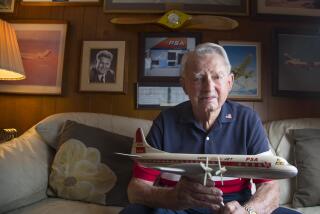OBITUARIES : Dean Smith; U.S. Airmail Pioneer Flier
- Share via
Dean Cullen Smith, who landed on everything from recently plowed fields to unsuspecting cows in the process of ferrying U.S. mail at the dawn of airmail service, is dead at age 86.
Smith, who had maintained a home in West Los Angeles before moving to Easton, Md., died March 4 in Easton, it was learned this week.
Smith, who signed with the U.S. Air Mail Service in 1919, the first of only eight years of operation before the deliveries were absorbed by commercial airlines, learned to fly as the result of a long-ago crap game. Smith’s sergeant-major promoted him from Army private to Army sergeant at Kelly Field in Texas to earn back a ring he had lost to the Smith who was then 16 years old.
Flight School
Armed with new stripes and the concomitant confidence, Smith applied for flight school and after 56 hours and 45 minutes of flying instruction was commissioned a second lieutenant who had hoped to see overseas service in World War I. But Smith showed such promise as a cadet that he was kept on as an Army flight instructor--at age 17 the youngest in Army history.
He was discharged in 1919 and barnstormed at carnivals and state and county fairs for a short time, saying years later that he quickly became tired of both the stunts and the terrified passengers that he took aloft to earn his pay.
In his 1960 book, “By the Seat of My Pants: A Pilot’s Progress From 1917 to 1930,” Smith wrote that he next “participated in the pioneering of scheduled air transportation in the United States, including the development of a transcontinental route, inaugurating cross-country night flying and inventing the art of instrument flying” that permitted the first scheduled mail service.
He also wrote that the crashes he had hoped to avoid as a barnstormer had accompanied him to his new job.
Lands on Cow
On one run out of Chicago his engine quit over a field where cattle were grazing and where he was forced to land.
The telegram he sent to the mail superintendent in Washington explaining the delay in mail delivery, has since often been quoted as a paragon of brevity:
“On Trip 4 westbound. Flying low. Engine quit. Only place to land on cow. Killed cow. Wrecked plane. Scared me. Smith.”
The wire may have been atypical but the crash wasn’t.
Mail planes in those days featured open cockpits with engines that either conked out or burned up. Pilots used road maps for navigation charts and the only knowledge they had of approaching weather was when they flew into it.
The service averaged a forced landing every 800 miles, Smith said, and a dead pilot every 80,000.
He quit the service to become a commercial pilot for United in 1927-28 and from 1928 to 1930 flew in Antarctica as a member of Richard E. Byrd’s expedition to that frozen continent.
He next joined the embryonic American Airlines and then went to work for Curtiss-Wright Corp. as a test pilot and sales executive. He quit flying commercially in 1943 and spent the remainder of his career as director of development for Fairchild Engine and Airplace Corp. and then as director of customer relations for Hughes Aircraft Co. His last job, in 1965, was as a consultant to Douglas Aircraft.
Highly Cited
Over the years he accumulated such awards as the Distinguished Flying Cross, the Harmon Trophy, given each year to the person judged to be America’s most outstanding pilot; the Collier Club Award and the Detroit News Aerial Trophy. He belonged to such pathfinding aviation groups as the Air Mail Pioneers Assn. and the Quiet Birdmen. He also was the last president of the National Air Pilots Assn. before it became the Airline Pilots Assn. and was named to the Aviation and OX5 Halls of Fame, both of the latter honors reserved for pioneer fliers.
And were all the scares and the unscheduled and haphazard landings worth it?
From his book.
“Threading one’s way through the great piles of summer cumulus that hang over the plains, the patches of ground that show far below through the white are for earthbound folk, and the cloud shapes are sculptured just for you. . . .”
More to Read
Sign up for Essential California
The most important California stories and recommendations in your inbox every morning.
You may occasionally receive promotional content from the Los Angeles Times.












